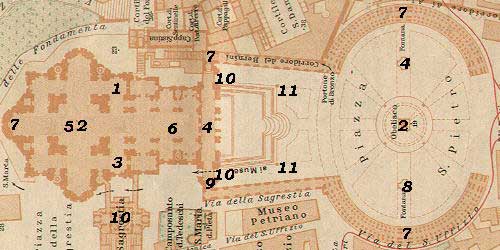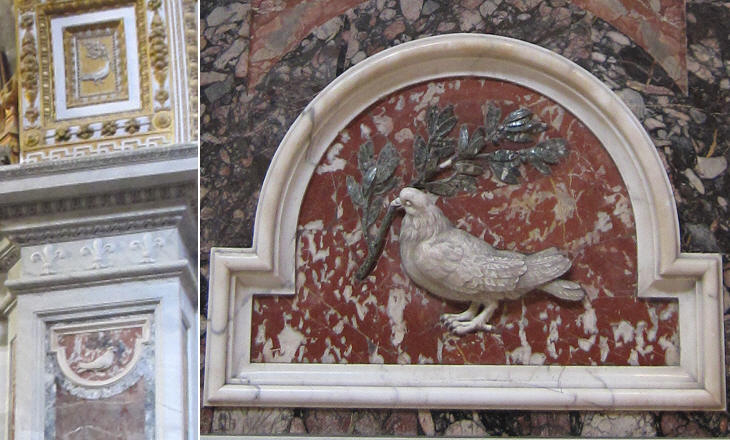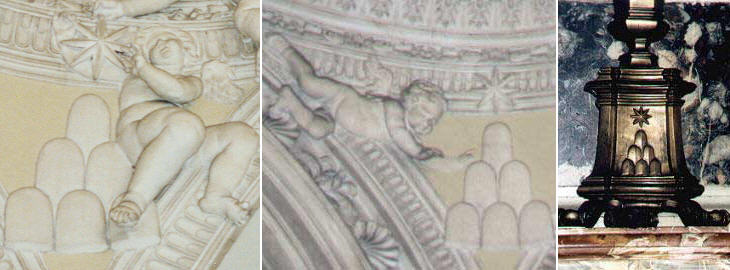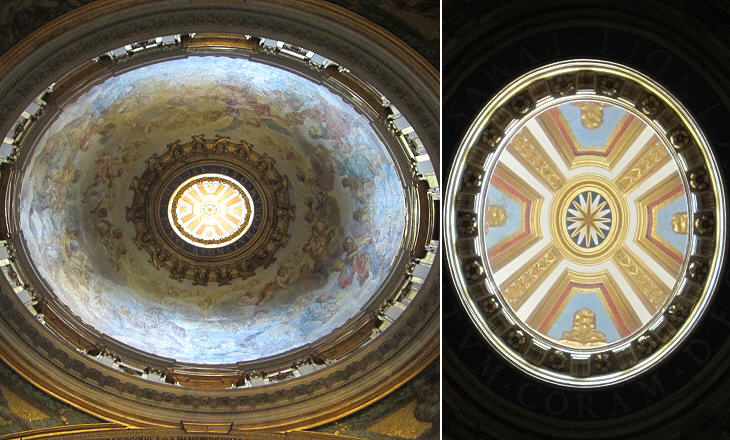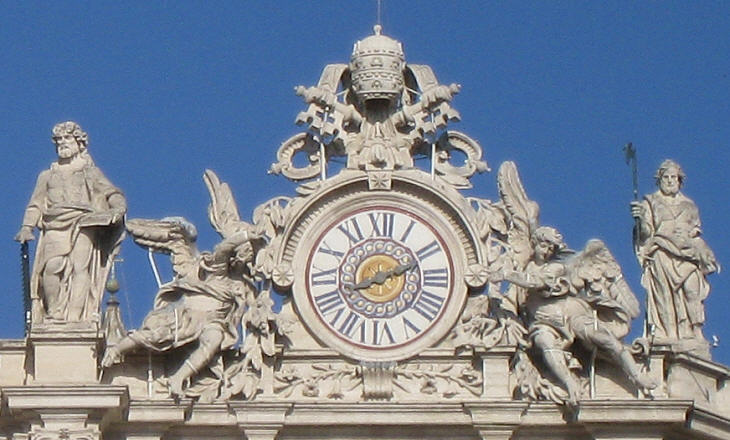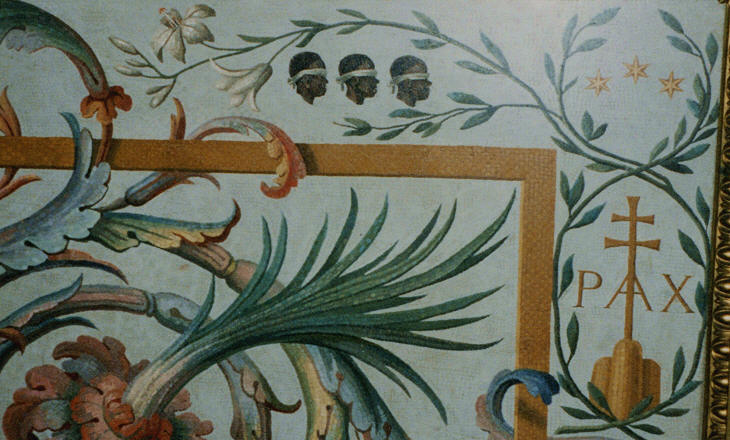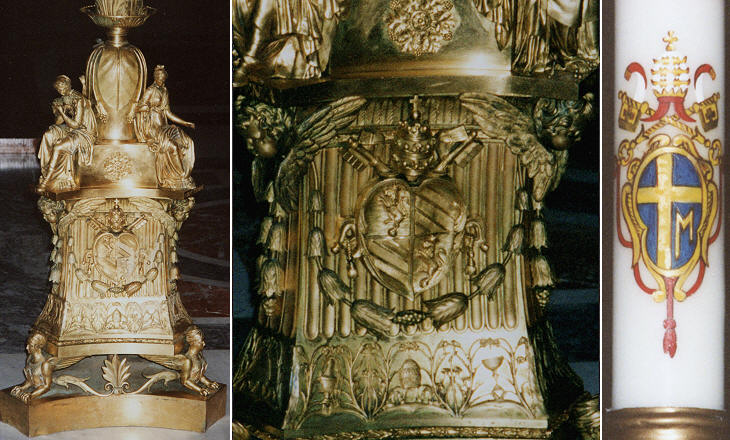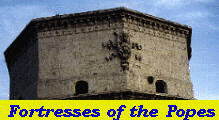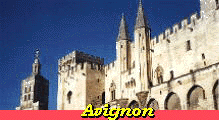  What's New! Detailed Sitemap All images © by Roberto Piperno, owner of the domain. Write to romapip@quipo.it. Text edited by Rosamie Moore. |
 A clue to the decoration of St Peter's A clue to the decoration of St Peter's
Introduction "Dalla Chiesa di S. Pietro ha il principio questa mia fatica, cioŔ dalla maggior fabrica, che tutti i secoli habbino ammirata, .... per accrescere la quale sono pi¨ volte restati esausti i tesori dell'Impero Christiano" (I begin my work with St Peter's, the greatest enterprise ever undertaken and the most admired one, .... for the embellishment of which more than once the finances of Christianity were exhausted). Filippo Titi opens with these words his 1674 summary of the works of art in the churches of Rome. He points out the three main features of St Peter's: its magnitude, its artistical value and its cost. St Peter's should more correctly be called New St Peter's (S. Pietro Nuovo), because it has replaced the large basilica of the IVth century which stood on the same site (S. Pietro Vecchio). The basilica had five naves and it was the largest church in Rome, but in the XVth century the popes felt the need to enlarge and redesign it. Pope Eugenius IV (1431-47) spent most of his pontificate in Florence and he attended there to the solemn ceremonies for the completion of the dome of the Cathedral. He was impressed by both the size and the beauty of the Cupola del Brunelleschi, the dome designed by Filippo Brunelleschi. The Cathedral of Florence (S. Maria del Fiore) was by far larger than S. Pietro Vecchio, its exterior was richly decorated with marble and the modern and daring design of its dome called for admiration. The successor of Eugenius IV, Nicholas V (1447-55) was the first to develop a plan for modernizing S. Pietro Vecchio by enlarging its apse with the objective of making more evocative the ceremonies of the Holy Year 1450. Pilgrims were one of the main resources of Rome and the Church; they came moved by religious fervour, but also attracted by the large basilicas (and by other worldly pleasures). The majority of them came to Rome through Florence and so they were in a position to compare the old and falling apart S. Pietro Vecchio with the new Cathedral of Florence. Julius II (1503-13) took the decision to replace S. Pietro Vecchio with a totally new basilica and he appointed a body (the still existing Fabbrica di S. Pietro) in charge of the task. On April 18, 1506 the first stone of the new basilica was laid down. The dimensions and the decoration of the new building were to be unsurpassable; the cost was too. The Reformation and the related religious wars, the Sack of Rome in 1527, the economic decline of Italy in the first half of the XVIth were events which slowed down the erection of S. Pietro Nuovo. The first part to be completed was Cappella Gregoriana named after Pope Gregory XIII (1572-85). The dome of the chapel was used as a test to verify the feasibility of the main dome. The map here below shows under which pope the various parts of St Peter's were completed and the whole page shows how the popes marked with their coats of arms or their heraldic symbols the parts which they had completed.
Legend:
Gregory XIII (1572-85) Gregory XIII was the first pope who saw the completion of a part of St Peter's. Cappella Gregoriana and the adjoining part of the right aisle are decorated with his formal coats of arms (in the pavement, walls, vault and in the balustrades of the altars). In addition the corridor leading to the right aisle hosts the monument to him by C. Rusconi. The decoration of the vault has a little surprise: at first sight it is decorated with golden cornucopias (horns of plenty) a traditional decorative theme; a closer look however shows that the end of the cornucopia is actually made of a dragon, the heraldic symbol of the pope. More information about Cappella Gregoriana and Gregory XIII is available at The Dragon and the Calendar.
Sixtus V (1585-90) The completion of St Peter's dome had been a nightmare for a long time. There were serious doubts whether the piers would actually be able to support the weight of the dome and il Vignola and Giacomo della Porta, the architects in charge after Michelangelo of completing the dome preferred to concentrate on the completion of Cappella Gregoriana and its twin Cappella Clementina. Pope Sixtus V was a very resolute character and in 1587 he asked Giacomo della Porta and his assistant Domenico Fontana to go ahead and complete the dome. The task, for the completion of which many thought ten years would not be enough, was completed in a couple of years and in 1590 Sixtus V celebrated the event with a great ceremony. The pope had a complex coat of arms with a lion holding pears and three mountains topped by a star. These symbols were used in the decoration of the drum of the dome and of the central line of windows. When the dome was completed the plan for St Peter's provided for a fašade very close to the dome; in this way the lions and the pears of the pope would have had great visibility, which was eventually significantly reduced by the final layout of the Basilica and of the square. Sixtus V gave another important contribution to the completion of St Peter's by moving to the square in front of the old basilica a large obelisk which stood in the nearby Circus of Nero. You can see the obelisk and the heraldic symbols of the pope in my page devoted to Piazza di S. Pietro. More information about the heraldic symbols of Sixtus V is available at Lions and Pears. See how the basilica appeared in a 1588 Guide to Rome.
Clement VIII (1592-1605) Pope Clement VIII was mainly involved in completing the decoration of the dome and of Cappella Clementina, named after him. The high altar under the dome was made with marbles taken from the Forum of Nerva. The decoration of Cappella Clementina followed the pattern of Cappella Gregoriana with a fine large mosaic showing the coat of arms of Clement VIII. In addition the pavement was decorated with marbles showing the stars and the stripes of his coat of arms. More information about the heraldic symbols of Clement VIII is available at Stars and Stripes.
Paul V (1605-21) Pope Paul V had a major role in the completion of St Peter's as he took the decision to modify the original project which was based on a Greek cross shape. St Peter's was given a Latin cross shape by increasing the eastern nave, which was in some way attracted by the obelisk. Carlo Maderno built a new fašade which replaced the still surviving fašade of Old St Peter's. It is shown in my page dedicated to Basilica di S. Pietro. Formal coats of arms of Paul V were placed on the fašade, the vault of the Portico (a stucco masterpiece by Martino Ferrabosco), the inner fašade and the vault of the nave (this coat of arms was replaced by a coat of arms of Pius VI in 1780), but the eagles and the dragons of Paul V appear in many other places on the fašade and in the nave. More information about the heraldic symbols of Paul V is available at Dragons and Eagles. Paul V was very proud of having reactivated an old Roman aqueduct and having brought a large amount of water (Acqua Paola) to the western part of Rome. This water was used to supply an existing fountain in Piazza di S. Pietro which was renovated by Carlo Maderno in 1614 with the addition of the heraldic symbols of Paul V (the background of this page shows an eagle of the fountain).
Urban VIII (1623-44) Pope Urban VIII had a great admiration for Gian Lorenzo Bernini who was charged with the design of the decoration of the area below the dome. He envisaged four colossal statues at the foot of the piers supporting the dome. The statues were located in niches decorated with the formal coats of arms of Urban VIII, but he also made use of the heraldic symbols of the pope (the bees and the sun) for the decoration of the pedestals of the statues. Bernini built also the gigantic Canopy of St Peter's decorated with eight puzzling coats of arms which you can see in my page A Laborious Delivery. More information about the heraldic symbols of Urban VIII is available at the Sun of the Barberini.
Innocent X (1644-55) Pope Innocent X asked Bernini to design the pavement of the Nave and the decoration of its pillars. To celebrate this addition to St Peter's he wanted six gigantic coats of arms (three on the inner fašade, two in the aisles and one on the pavement), but he also had his doves and his fleurs-de-lis used as a theme for the decoration of the pillars. More information about the heraldic symbols of Innocent X is available at Where the Dove Flies.
Alexander VII (1655-67) Pope Alexander VII tackled the main remaining issue for the completion of St Peter's and again Gian Lorenzo Bernini was asked to help. The square in front of the church was a rather haphazard assemblage of monuments (including a tower built by Martino Ferrabosco at the beginning of the century) which did not fit with the basilica. The pope discussed personally with Bernini the various options and eventually endorsed the elliptical doric colonnades proposed by Bernini, both for their spiritual meaning (the arms of the Church embracing mankind) and for their effect in enhancing the vertical lines of the fašade. Six gigantic formal coats of arms of Alexander VII celebrate the completion of Piazza di S. Pietro. Alexander VII entrusted Bernini with the redesign of the access to the Vatican from Piazza S. Pietro. It is called Scala Regia and in addition to a large formal coat of arms it is decorated with the six mountains and the star of Alexander VII. The third major addition to St Peter's is the Chair of St Peter, a complex monument where Bernini made use of the experience gained in S. Maria in Aracoeli in dealing with the light coming through coloured glasses. Four coats of arms of Alexander VII embellish the base of the monument. The six mountains and the star of the pope appear also in many other places in the basilica, including several candlesticks. More information about the heraldic symbols of Alexander VII is available at Six Mountains and a Star.
Clement X (1670-76) During the pontificate of Clement X, Gian Lorenzo Bernini was asked to design for the portico a pavement similar to that of the nave and to add another fountain to the existing one in Piazza di S. Pietro. Both additions were celebrated with coats of arms.
Clement XI (1700-21) Pope Clement XI gave symmetry to the portico by building a monument to Charlemagne opposite to the statue of Constantine in Scala Regia and decorating its vault with his coat of arms. His heraldic symbols (three mountains and a star) appear in the six elliptical domes which give light to the aisles. These domes had been painted in the XVIIth century. The image here below shows the dome in front of Cappella del SS. Sacramento, painted by Pietro da Cortona in 1653. More information about the heraldic symbols of Clement XI is available at A Pope from Urbino.
Pius VI (1775-99) Pope Pius VI was eager to add his name to the list of the popes who built St Peter's and he took the occasion of some restorations of the vault to replace the coat of arms of Paul V with his own. He also added his coat of arms to those of Paul V and Urban VIII at the entrance to the portico. However he actually made a large addition to St Peter's by building a new sacristy. He also closed the issue of the bell towers of St Peter's by putting on top of them two gigantic clocks designed by Giuseppe Valadier. The heraldic symbols of the pope are not very evident, but they are there: three stars and plants of lilies. More information about the heraldic symbols of Pius VI is available at The Wind was too Strong.
Pius VII (1800-23) The pontificate of Pope Pius VII was a very difficult one. The pope was for many years away from Rome, which for some years was part of the French Empire. He returned to Rome in 1815 and devoted himself to restoring the collections of paintings and statues of the Church, which had suffered from the French occupation. Apart from the neoclassical Monument to him by the Danish sculptor Albert Thorwaldsen, St Peter's does not seem to retain any other memories of his pontificate. An altar in the transept however is decorated with his heraldic symbols.
Pius IX (1846-78) The long pontificate of Pope Pius IX saw some minor additions to St Peter's. When he reached in 1871 his 25th year in office the XIIIth century bronze statue of St Peter was put under a sort of canopy topped by a portrait of the pope because Pius IX had exceeded the term in office of the Apostle. In 1847 he replaced the existing statues of St Peter and St Paul in Piazza di S. Pietro with larger ones. His coats of arms (usually of a small size) can be found in several places in the square and inside the basilica.
Note: some of the coats of arms in the basilica and in the square can be seen in the section devoted to Filippo Juvarra. |
